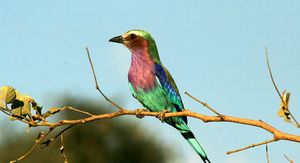List of birds of Zambia
This is a list of bird species recorded in Zambia. The avifauna of Zambia include a total of 779 species, of which one is endemic, one has been introduced by humans and four are rare or accidental. Eleven species are globally threatened.
This list's taxonomic treatment (designation and sequence of orders, families and species) and nomenclature (common and scientific names) follow the conventions of The Clements Checklist of Birds of the World, 5th edition. The family accounts at the beginning of each heading reflect this taxonomy, as do the species counts found in each family account. Introduced and accidental species are included in the total counts for Zambia.
The following tags have been used to highlight several categories. The commonly occurring native species do not fall into any of these categories.
- (A) Accidental - a species that rarely or accidentally occurs in Zambia
- (E) Endemic - a species endemic to Zambia
- (I) Introduced - a species introduced to Zambia as a consequence, direct or indirect, of human actions
_NOTOC__
Ostriches
Order: StruthioniformesScript error: No such module "String".Family: Struthionidae
The ostrich is a flightless bird native to Africa. It is the largest living species of bird. It is distinctive in its appearance, with a long neck and legs and the ability to run at high speeds.
- Ostrich, Struthio camelus
Grebes
Order: Podicipediformes Script error: No such module "String".Family: Podicipedidae
Grebes are small to medium-large freshwater diving birds. They have lobed toes and are excellent swimmers and divers. However, they have their feet placed far back on the body, making them quite ungainly on land. There are 20 species worldwide and 2 species which occur in Zambia.
- Little grebe, Tachybaptus ruficollis
- Great crested grebe, Podiceps cristatus
Cormorants
Order: Suliformes Script error: No such module "String".Family: Phalacrocoracidae
Phalacrocoracidae is a family of medium to large coastal, fish-eating seabirds that includes cormorants and shags. Plumage colouration varies, with the majority having mainly dark plumage, some species being black-and-white and a few being colourful.
- Long-tailed cormorant, Microcarbo africanus
- White-breasted cormorant, Phalacrocorax lucidus
Darters
Order: Suliformes Script error: No such module "String".Family: Anhingidae
Darters are often called "snake-birds" because of their long thin neck, which gives a snake-like appearance when they swim with their bodies submerged. The males have black and dark-brown plumage, an erectile crest on the nape and a larger bill than the female. The females have much paler plumage especially on the neck and underparts. The darters have completely webbed feet and their legs are short and set far back on the body. Their plumage is somewhat permeable, like that of cormorants, and they spread their wings to dry after diving.
- African darter, Anhinga melanogaster
Pelicans
Order: Pelecaniformes Script error: No such module "String".Family: Pelecanidae
Pelicans are large water birds with a distinctive pouch under their beak. As with other members of the order Pelecaniformes, they have webbed feet with four toes.
- Great white pelican, Pelecanus onocrotalus
- Pink-backed pelican, Pelecanus rufescens
Darters
Order: Suliformes Script error: No such module "String".Family: Anhingidae
Darters are often called "snake-birds" because of their long thin neck, which gives a snake-like appearance when they swim with their bodies submerged. The males have black and dark-brown plumage, an erectile crest on the nape and a larger bill than the female. The females have much paler plumage especially on the neck and underparts. The darters have completely webbed feet and their legs are short and set far back on the body. Their plumage is somewhat permeable, like that of cormorants, and they spread their wings to dry after diving.
- African darter, Anhinga melanogaster
Pelicans
Order: Pelecaniformes Script error: No such module "String".Family: Pelecanidae
Pelicans are large water birds with a distinctive pouch under their beak. As with other members of the order Pelecaniformes, they have webbed feet with four toes.
- Great white pelican, Pelecanus onocrotalus
- Pink-backed pelican, Pelecanus rufescens
References
- Lua error in ...ribunto/includes/engines/LuaCommon/lualib/mwInit.lua at line 23: bad argument #1 to 'old_ipairs' (table expected, got nil).
- Lua error in ...ribunto/includes/engines/LuaCommon/lualib/mwInit.lua at line 23: bad argument #1 to 'old_ipairs' (table expected, got nil).
External links
- Birds of Zambia - World Institute for Conservation and Environment

